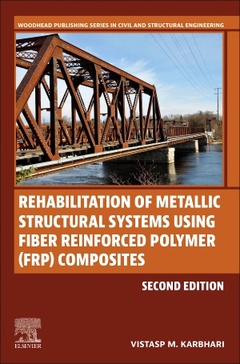Description
Rehabilitation of Metallic Structural Systems Using Fiber Reinforced Polymer (FRP) Composites (2nd Ed.)
Woodhead Publishing Series in Civil and Structural Engineering Series
Language: English
Subjects for Rehabilitation of Metallic Structural Systems Using...:
740 p. · 15x22.8 cm · Paperback
Description
/li>Contents
/li>Biography
/li>Comment
/li>
Rehabilitation of Metallic Structural Systems Using Fiber-Reinforced Polymer (FRP) Composites, Second Edition provides comprehensive knowledge on the application of FRPs in various types of metallic field structures. Part I provides an overview of the various types of materials and systems and discusses the durability of bonds. Part II focuses on materials-level considerations, such as corrosion and mechanical behavior, putty effects on the effectiveness of pipeline systems, laser joining and the use of carbon and basalt FRP for underwater repair. Building on Part II, the final three sections focus on applications of FRP composites to steel components and various infrastructure systems. This book will be a standard reference for civil engineers, designers, materials scientists, and other professionals who are involved in the rehabilitation of metallic structures using fiber reinforced polymer composites.
1. Materials and Systems Level Overview
2. Durability of bonds using experimental and Multiphysics simulations
3. Durability of steel components strengthened with FRP composites
4. Effect of temperature on bond behavior
Part II: Materials Level Considerations
5. Corrosion and mechanical behavior of hybrid stee/FRP structures when subjected to different loading and environmental conditions
6. Putty effects on the effectiveness of FRP repair of steel pipeline systems
7. Laser joining of metals with carbon fiber PEEK
8. Use of carbon and basalt FRP for underwater repair of steel structures
Part III: Application to Components
9. Enhancing the stability of structural steel components using FRP composites
10. Strengthening of thin-walled steel sections using FRP composites
11. Rehabilitation of cracked aluminum components using FRP composites
12. FRP strengthening of long steel columns against buckling
13. FRP strengthening of corroded steel plates
14. FRP repair of steel tanks
15. FRP for underwater strengthening of steel structures
Part IV: Application to Components
16. Fatigue life of steel components strengthened with FRP composites
17. FRP repair for enhanced fatigue of steel structures
18. Optimization of patches for fatigue repair of steel
19. FRP repair of CHS Members subject to cyclic loads
Part V: Application to Infrastructure Systems
20. Assessment and rehabilitation of steel railway bridges using FRP composites
21. Strengthening of historic metallic structures using FRP composites
22. FRP repair of cracked metallic pipelines
23. FRP rehabilitation of steel bridge decks
24. Analysis of reliability corroded pipe repair by FRP
25. FRP repair of navigation steel structures
- Contains eighteen new chapters covering materials-level aspects and applications
- Presents materials developments for tailored bonds, durability, and bond behavior
- Includes methods of analysis, testing, and implementation across a broad range of sectors
- Covers design aspects, guidelines, and codes
- Discusses economic aspects and future prospects




